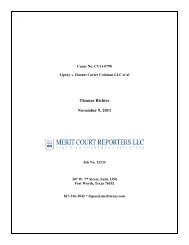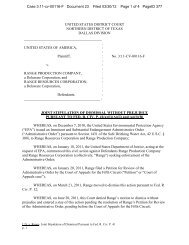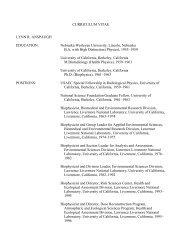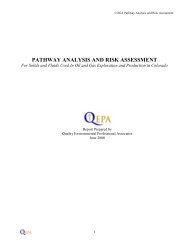Gasland - Colorado Oil and Gas Conservation Commission
Gasland - Colorado Oil and Gas Conservation Commission
Gasland - Colorado Oil and Gas Conservation Commission
You also want an ePaper? Increase the reach of your titles
YUMPU automatically turns print PDFs into web optimized ePapers that Google loves.
DEPARTMENT OF NATURAL RESOURCES<br />
Bill Ritter, Jr., Governor<br />
1120 Lincoln St. Suite 801<br />
Denver, CO 80203<br />
Phone: (303) 894-2100<br />
FAX: (303) 894-2109<br />
www.colorado.gov/cogcc<br />
The documentary <strong><strong>Gas</strong>l<strong>and</strong></strong> has attracted wide attention. Among other things, it alleges that the<br />
hydraulic fracturing of oil <strong>and</strong> gas wells has contaminated nearby water wells with methane in a<br />
number of states including <strong>Colorado</strong>. Because an informed public debate on hydraulic<br />
fracturing depends on accurate information, the <strong>Colorado</strong> <strong>Oil</strong> <strong>and</strong> <strong>Gas</strong> <strong>Conservation</strong><br />
<strong>Commission</strong> (COGCC) would like to correct several errors in the film’s portrayal of the <strong>Colorado</strong><br />
incidents.<br />
Background<br />
Methane is a natural hydrocarbon gas that is flammable <strong>and</strong> explosive in certain concentrations.<br />
It is produced either by bacteria or by geologic processes involving heat <strong>and</strong> pressure. Biogenic<br />
methane is created by the decomposition of organic material through fermentation, as is<br />
commonly seen in wetl<strong>and</strong>s, or by the chemical reduction of carbon dioxide. It is found in some<br />
shallow, water-bearing geologic formations, into which water wells are sometimes completed.<br />
Thermogenic methane is created by the thermal decomposition of buried organic material. It is<br />
found in rocks buried deeper within the earth <strong>and</strong> is produced by drilling an oil <strong>and</strong> gas well <strong>and</strong><br />
hydraulically fracturing the rocks that contain the gas. In <strong>Colorado</strong>, thermogenic methane is<br />
generally associated with oil <strong>and</strong> gas development, while biogenic methane is not.<br />
The analytical methods use to differentiate between the two types of methane are well-known,<br />
scientifically accepted, <strong>and</strong> summarized in a well-known presentation by Dennis Coleman <strong>and</strong><br />
papers by I.R. Kaplan <strong>and</strong> Dennis Coleman. These works, in turn, cites nearly 75 other<br />
references related to the topics of methane generation, “fingerprinting,” forensic investigations,<br />
<strong>and</strong> stable isotope geochemistry.<br />
Based upon our review of hundreds of <strong>Colorado</strong> gas samples over many years, the COGCC is<br />
able to differentiate between biogenic <strong>and</strong> thermogenic methane using both stable isotope<br />
analysis of the methane <strong>and</strong> compositional analysis of the gas. In the Denver-Julesburg <strong>and</strong><br />
Piceance Basins, the COGCC has consistently found that biogenic gas contains only methane<br />
<strong>and</strong> a very small amount of ethane, while thermogenic gas contains not just methane <strong>and</strong><br />
ethane but also heavier hydrocarbons such as propane, butane, pentane, <strong>and</strong> hexanes.<br />
As explained below, <strong><strong>Gas</strong>l<strong>and</strong></strong> incorrectly attributes several cases of water well contamination in<br />
<strong>Colorado</strong> to oil <strong>and</strong> gas development when our investigations determined that the wells in<br />
question contained biogenic methane that is not attributable to such development.<br />
The Weld County Wells<br />
<strong><strong>Gas</strong>l<strong>and</strong></strong> features three Weld County l<strong>and</strong>owners, Mike Markham, Renee McClure, <strong>and</strong> Aimee<br />
Ellsworth, whose water wells were allegedly contaminated by oil <strong>and</strong> gas development. The<br />
COGCC investigated complaints from all three l<strong>and</strong>owners in 2008 <strong>and</strong> 2009, <strong>and</strong> we issued<br />
written reports summarizing our findings on each. We concluded that Aimee Ellsworth’s well<br />
contained a mixture of biogenic <strong>and</strong> thermogenic methane that was in part attributable to oil <strong>and</strong><br />
gas development, <strong>and</strong> Mrs. Ellsworth <strong>and</strong> an operator reached a settlement in that case.<br />
DEPARTMENT OF NATURAL RESOURCES: Mike King, Executive Director<br />
COGCC COMMISSION: Richard Alward – Thomas L. Compton – DeAnn Craig – Mark Cutright – Michael Dowling – Joshua B. Epel – Trési Houpt – Mike King – Martha Rudolph<br />
COGCC STAFF: David Neslin, Director – Margaret Ash, Field Inspection Manager – Debbie Baldwin, Environmental Manager – Stuart Ellsworth, Engineering Manager –Carol Harmon, Hearings Manager
However, using the same investigative techniques, we concluded that Mike Markham’s <strong>and</strong><br />
Renee McClure’s wells contained biogenic gas that was not related to oil <strong>and</strong> gas activity.<br />
Unfortunately, <strong><strong>Gas</strong>l<strong>and</strong></strong> does not mention our McClure finding <strong>and</strong> dismisses our Markham<br />
finding out of h<strong>and</strong>.<br />
The Markham <strong>and</strong> McClure water wells are both located in the Denver-Julesburg Basin in Weld<br />
County. They <strong>and</strong> other water wells in this area draw water from the Laramie-Fox Hills Aquifer,<br />
which is composed of interbedded s<strong>and</strong>stones, shales, <strong>and</strong> coals. Indeed, the water well<br />
completion report for Mr. Markham’s well shows that it penetrated at least four different coal<br />
beds. The occurrence of methane in the coals of the Laramie Formation has been well<br />
documented in numerous publications by the <strong>Colorado</strong> Geological Survey, the United States<br />
Geological Survey, <strong>and</strong> the Rocky Mountain Association of Geologists dating back more than 30<br />
years. For example, a 1976 publication by the <strong>Colorado</strong> Division of Water Resources states<br />
that the aquifer contains “troublesome amounts of . . . methane.” A 1983 publication by the<br />
United States Geological Survey similarly states that “[m]ethane-rich gas commonly occurs in<br />
ground water in the Denver Basin, southern Weld County, <strong>Colorado</strong>.” And a 2001 report by the<br />
<strong>Colorado</strong> Geological Survey discusses the methane potential of this formation <strong>and</strong> cites<br />
approximately 30 publications on this subject.<br />
Laboratory analysis confirmed that the Markham <strong>and</strong> McClure wells contained biogenic<br />
methane typical of gas that is naturally found in the coals of the Laramie–Fox Hills Aquifer. This<br />
determination was based on a stable isotope analysis, which effectively “finger-printed” the gas<br />
as biogenic, as well as a gas composition analysis, which indicated that heavier hydrocarbons<br />
associated with thermogenic gas were absent. In addition, water samples from the wells were<br />
analyzed for benzene, toluene, ethylbenzene, <strong>and</strong> xylenes (BTEX), which are constituents of<br />
the hydrocarbons produced by oil <strong>and</strong> gas wells in the area. The absence of any BTEX<br />
compounds in these water samples provided additional evidence that oil <strong>and</strong> gas activity did not<br />
contaminate the Markham <strong>and</strong> McClure wells.<br />
The COGCC has also reviewed the records for all oil <strong>and</strong> gas wells located within one-half mile<br />
of the Markham <strong>and</strong> McClure wells, which is more than double the typical hydraulic fracture<br />
length in <strong>Colorado</strong>. This review indicated that: all oil <strong>and</strong> gas wells near the Markham well were<br />
drilled <strong>and</strong> hydraulically fractured in 1991, except for two wells that were fractured in 2005 <strong>and</strong><br />
2006, respectively; <strong>and</strong> all oil <strong>and</strong> gas wells near the McClure well were drilled <strong>and</strong> hydraulically<br />
fractured in 2002, except for one well that was hydraulically fractured in 2005. The records do<br />
not reflect any pressure failures or other problems associated with these wells that would<br />
indicate a loss of fracture fluid or gas from the well bore into the surrounding geologic<br />
formations.<br />
In support of its thesis that the Markham <strong>and</strong> McClure water wells were contaminated by oil <strong>and</strong><br />
gas development, the <strong><strong>Gas</strong>l<strong>and</strong></strong> website makes several arguments that merit a brief response.<br />
First, the website quotes Professor Anthony Ingraffea of Cornell University for the proposition<br />
that drilling <strong>and</strong> hydraulic fracturing could cause biogenic methane to migrate into aquifers<br />
under certain circumstances. However, Professor Ingraffea’s statement does not suggest that<br />
these circumstances apply to the Markham <strong>and</strong> McClure wells, nor does it address the<br />
extensive scientific literature establishing that biogenic methane is naturally present in the<br />
aquifer in question. Second, the website quotes Weston Wilson, an Environmental Protection<br />
Agency employee, speculating that oil <strong>and</strong> gas operators in Weld County are withdrawing large<br />
amounts of groundwater <strong>and</strong> that these withdrawals are releasing biogenic methane. However,<br />
oil <strong>and</strong> gas companies in Weld County obtain most of their water from municipalities, which<br />
obtain such water from surface water sources such as the <strong>Colorado</strong>-Big Thompson <strong>and</strong> Windy
Gap projects. Finally, the website asserts that the water in the Markham <strong>and</strong> McClure wells<br />
deteriorated after drilling <strong>and</strong> hydraulic fracturing occurred nearby. However, COGCC records<br />
indicate little or no temporal relationship between the Markham <strong>and</strong> McClure complaints <strong>and</strong><br />
nearby drilling <strong>and</strong> hydraulic fracturing activities, which occurred several years earlier <strong>and</strong> in<br />
most cases many years earlier.<br />
The West Divide Creek Seeps<br />
<strong><strong>Gas</strong>l<strong>and</strong></strong> also addresses complaints about oil <strong>and</strong> gas activity in the West Divide Creek area of<br />
the Piceance Basin in Garfield County, though it again confuses issues related to biogenic gas<br />
with those related to thermogenic gas. The film focuses on two seeps that are in close<br />
geographic proximity but derive from different origins. One of the seeps occurs in a wetl<strong>and</strong> on<br />
property owned by Lisa Bracken, who appears in the film; it contains biogenic methane. The<br />
other seep, which the COGCC terms the West Divide Creek gas seep, is about 1,500 feet to the<br />
south on property owned by a neighbor; it contains thermogenic methane caused by EnCana’s<br />
failure to properly cement a natural gas well.<br />
<strong><strong>Gas</strong>l<strong>and</strong></strong> adopts the claim that the West Divide Creek gas seep was caused by hydraulic<br />
fracturing. After investigating the matter thoroughly in 2004, COGCC staff concluded the seep<br />
was caused by gas migrating up a gas well borehole that had not been properly cemented <strong>and</strong><br />
in which the upper portion of the gas bearing Williams Fork Formation had not been isolated. On<br />
August 16, 2004, following a public hearing, the COGCC commissioners approved an<br />
enforcement order (Order 1V-276) that incorporated the staff’s causation conclusions <strong>and</strong><br />
assessed a substantial fine against the operator.<br />
In investigating the West Divide gas seep, the COGCC determined that it contains thermogenic<br />
methane. The gas composition <strong>and</strong> stable isotope signature of the gas closely matched that of<br />
the gas being produced from the Williams Fork Formation. The gas from both the West Divide<br />
Creek seep <strong>and</strong> the Williams Fork Formation is composed primarily of methane, but it also<br />
contains ethane, propane, butane, pentane, <strong>and</strong> hexanes. In addition, BTEX compounds were<br />
detected in ground <strong>and</strong> surface water in the vicinity of the West Divide Creek seep, which<br />
indicates that the gas is related to oil <strong>and</strong> gas activities <strong>and</strong> not of biogenic origin.<br />
In contrast, the laboratory results for the gas samples collected from the seep on Ms. Bracken’s<br />
property have demonstrated that the gas is biogenic. The COGCC has collected nine gas<br />
samples on six different occasions during 2004, 2007, 2009, <strong>and</strong> 2010. With respect to each<br />
sample, the gas composition was found to be 100 percent methane, no heavier hydrocarbon<br />
compound was detected, <strong>and</strong> the stable isotope ratio indicated that the gas is biogenic. The<br />
COGCC has also collected six water samples on four different occasions during 2004, 2007,<br />
<strong>and</strong> 2009 <strong>and</strong> ten soil samples on multiple occasions during 2008 <strong>and</strong> 2009 from Ms. Bracken’s<br />
property. BTEX compounds <strong>and</strong>/or other hydrocarbons associated with oil <strong>and</strong> gas operations<br />
were not detected in any of these samples. Based on these results, the COGCC has concluded<br />
that the gas seep on Ms. Bracken’s property resulted from the fermentation of organic matter by<br />
methanogenic bacteria. This is not uncommon in wetl<strong>and</strong> areas, such as those that exist along<br />
West Divide Creek.<br />
Other Information<br />
<strong>Oil</strong> <strong>and</strong> gas development is an industrial activity, <strong>and</strong> property owners sometimes complain that<br />
it has contaminated their water well. The COGCC investigates all such complaints <strong>and</strong> reports<br />
the results individually to the complainant <strong>and</strong> collectively to the <strong>Colorado</strong> Water Quality Control
Division. In some cases, the COGCC has found that the well contains thermogenic methane<br />
linked to oil <strong>and</strong> gas development. In most cases, however, the COGCC has found that<br />
contamination is not present or that the methane comes from biogenic sources <strong>and</strong> is not<br />
attributable to oil <strong>and</strong> gas production. The following excerpt from a report summarizing the<br />
COGCC’s investigation following the contamination of the Ellsworth water well is illustrative:<br />
In response to concerns regarding the presence of methane gas in water<br />
wells completed in the Laramie/Fox Hills Aquifer, COGCC, Noble Energy,<br />
<strong>and</strong> Anadarko/Kerr McGee sampled a total of 28 water wells between March<br />
25, 2009 <strong>and</strong> April 7, 2009 across an approximately 170 square mile area.<br />
Sample results show that these wells contained either no methane gas or<br />
biogenic (biological generated) methane gas. None of these wells, other than<br />
the Ellsworth water well, contained thermogenic methane gas. The sample<br />
results along with letters discussing the results were sent by COGCC staff to<br />
the 28 well owners [who had requested testing].<br />
Nevertheless, it remains important to establish prudent regulations to ensure that other<br />
resources, such as groundwater, are protected. Producing oil <strong>and</strong> gas formations in much of<br />
<strong>Colorado</strong>, including the Denver-Julesburg <strong>and</strong> Piceance Basins, lie at depths of up to 8,000 feet<br />
below the ground surface, while the aquifers that sustain domestic water wells are generally<br />
less than 1,000 feet below the ground surface. COGCC regulations establish casing <strong>and</strong><br />
cementing st<strong>and</strong>ards to ensure that gas being produced from 8,000 feet down does not leak into<br />
the shallower aquifers. These regulations require wells to be cased with steel pipe <strong>and</strong> the<br />
casing to be surrounded by cement to create a hydraulic seal within the annular space between<br />
the wall of the well bore <strong>and</strong> the steel pipe. In addition, a number of recent amendments to the<br />
COGCC regulations address concerns raised about hydraulic fracturing:<br />
• Rule 205 requires operators to inventory chemicals, including fracturing fluids,<br />
<strong>and</strong> to provide this information upon request to the COGCC <strong>and</strong> certain health<br />
care professionals;<br />
• Rule 317 requires cement bond logs to confirm that aquifers are protected;<br />
• Rule 317B imposes m<strong>and</strong>atory setbacks <strong>and</strong> enhanced environmental<br />
precautions on oil <strong>and</strong> gas development occurring near public drinking water<br />
sources;<br />
• Rule 341 requires well pressures to be monitored during hydraulic fracturing;<br />
• Rule 608 m<strong>and</strong>ates additional pressure testing <strong>and</strong> water well sampling for<br />
coalbed methane wells; <strong>and</strong><br />
• Rules 903 , 904 , <strong>and</strong> 906 impose enhanced requirements for pit permitting,<br />
lining, monitoring, <strong>and</strong> secondary containment to ensure that pit fluids, including<br />
hydraulic fracturing flowback, do not leak.<br />
Finally, it should be understood that the COGCC Director, Dave Neslin, offered to speak with<br />
<strong><strong>Gas</strong>l<strong>and</strong></strong>’s producer, Josh Fox, on camera during the filming of the movie. Because the issues<br />
are technical <strong>and</strong> complex <strong>and</strong> arouse concerns in many people, Director Neslin asked that he<br />
be allowed to review any material from the interview that would be included in the final film.<br />
Unfortunately, Mr. Fox declined. Such a discussion might have prevented the inaccuracies<br />
noted above.










